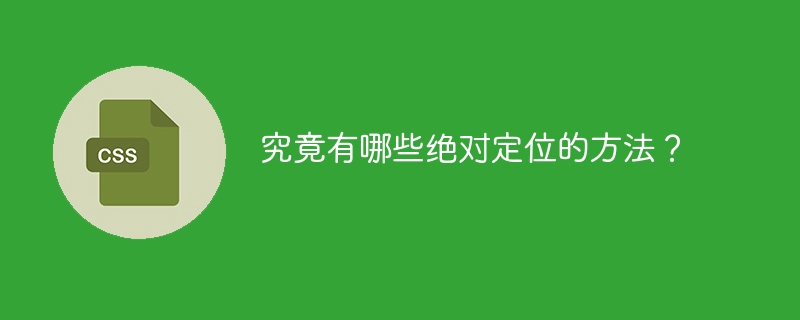Home >Web Front-end >CSS Tutorial >What are the options for absolute positioning?
What are the options for absolute positioning?
- WBOYWBOYWBOYWBOYWBOYWBOYWBOYWBOYWBOYWBOYWBOYWBOYWBOriginal
- 2024-01-23 09:22:05635browse

What are the absolute positioning methods?
In front-end development, absolute positioning is a commonly used layout method. With absolute positioning, we can place an element exactly at a specified location on the page without being affected by other elements. So, what are the absolute positioning methods? This article will introduce several common absolute positioning methods and provide corresponding code examples.
- Using the position attribute
In CSS, we can use the position attribute to specify how an element is positioned. Among them, the position attribute has the following values to choose from:
- static (default value): The elements are laid out according to the normal document flow, and absolute positioning is not used.
- relative: The element is positioned relative to its normal position. You can use the top, bottom, left, and right attributes to adjust the position of the element.
- absolute: The element is positioned relative to the nearest non-statically positioned ancestor element. If there is no non-statically positioned ancestor element, it is positioned relative to the body element.
- fixed: The element is positioned relative to the browser window, and the element's position will not change even if the page is scrolled.
The following is an example of using absolute positioning:
<style>
.parent {
position: relative;
width: 200px;
height: 200px;
background-color: #eee;
}
.child {
position: absolute;
top: 50px;
left: 50px;
width: 100px;
height: 100px;
background-color: #ff00ff;
}
</style>
<div class="parent">
<div class="child"></div>
</div>In the above example, the position attribute value of the parent element is relative, so that the child element .child is positioned relative to the parent element . By adjusting the values of the top and left attributes, we can position the child element at the specified position of the parent element.
- Using the transform attribute
In addition to the position attribute, we can also use the transform attribute to achieve absolute positioning. You can position an element at a specified offset by setting its translate attribute.
The following is an example of using the transform attribute:
<style>
.element {
width: 100px;
height: 100px;
background-color: #ff0000;
transform: translate(50px, 50px);
}
</style>
<div class="element"></div>In the above example, through the translate function of the transform attribute, we moved the element to the position of (50px, 50px).
- Using the calc function
Another way to achieve absolute positioning is to use the calc function. The calc function can be used to dynamically calculate attribute values and position elements to the required positions.
The following is an example of using the calc function:
<style>
.element {
width: 100px;
height: 100px;
background-color: #00ff00;
position: absolute;
top: calc(50% - 50px);
left: calc(50% - 50px);
}
</style>
<div class="element"></div>In the above example, we use the calc function to position the element to the center of the screen. No matter how the screen size changes, the element is always on the screen. central.
Summary:
Absolute positioning is one of the commonly used layout methods in front-end development. It can accurately position elements, making the page layout more flexible and diverse. This article introduces the method of using the position attribute, transform attribute and calc function to achieve absolute positioning, and provides corresponding code examples. I hope readers can master these absolute positioning methods through this article and be able to flexibly apply them in actual projects.
The above is the detailed content of What are the options for absolute positioning?. For more information, please follow other related articles on the PHP Chinese website!
Related articles
See more- Detailed explanation of the impact of CSS absolute positioning on element width
- How CSS implements absolute positioning and centering technology for horizontal and vertical centering
- What is html fixed positioning
- Learn to implement fixed positioning of elements and master the steps and techniques for fixed positioning of elements.

